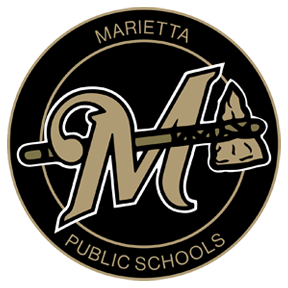Dyslexia is a learning disorder that involves difficulty reading due to problems identifying speech sounds and learning how they relate to letters and words. Also called a reading disability, dyslexia is a result of individual differences in areas of the brain that process language.
Dyslexia is not due to lack of intelligence or problems with hearing or vision. Most children with dyslexia can succeed in school with tutoring or a specialized education program, and many learn skills to help cope with dyslexia and become excellent students.
Though there's no cure for dyslexia, early assessment and intervention result in the best outcome.
“Most of the time, dyslexia is caught by the school because we work with the kids more on those specific things,” said Maverick McClendon, Director of Special Education for Marietta Public Schools. “Once in a while, we do have a parent who comes to us with concerns, but most of the time it’s either a classroom teacher or a screening program that we use that flags a student.”
The district has recently begun using a new program called Amiria, which is designed to catch signs of dyslexia. The program provides information that is referred to the special education teacher and McClendon, both of whom are trained to perform assessments. If needed, a psychologist or psychometrist is brought in for an official diagnosis.
“We watch closely for signs of dyslexia, particularly in the primary school, mainly because if it’s diagnosed early, those are the students who can be helped the most,” explained McClendon. “When it comes to dyslexia, early intervention is the key. If you don’t notice the struggle and catch it early, by the time a student reaches upper elementary and middle school, it becomes substantially more difficult to treat.
“By the time a student gets that far along in school, they’ve missed learning the reading techniques, and since a student never outgrows dyslexia, catching it early means that they can be taught coping skills to help them overcome some of the struggles. The younger a student is, the easier it is for them to learn to make the corrections and learn the skills they need to become effective readers.”
McClendon added that at the primary level, teachers do all they can to catch the signs of dyslexia so that coping skills can be taught and students won’t struggle as much in upper elementary, middle, and high school.
According to McClendon, it’s difficult to address just how common dyslexia is because it was not recognized in Oklahoma as a disability until roughly two years ago.
“We’re seeing more dyslexia now,” he explained, “but I’m not sure whether that’s because there are more instances of dyslexia, or because it’s just being diagnosed more.”
As a parent, if your child’s teacher speaks to you about assessing your child for dyslexia, McClendon has advice.
“Do your research. Understand what it is and how to help,” McClendon said. “We give parents tips and tools to use, but the most important thing is to be consistent. Read with your child every day. If they struggle with sounds or letters, point those out until it becomes a habit for the student to correct themselves.”
Like any skill for any person, McClendon insists that practice and repetition are keys.
If your child is diagnosed with dyslexia, all public schools have programs in place that meet students at their point of need, and the outlook is positive.
“Sometimes we find that students have other things besides dyslexia, and that does create other issues, but when it comes to dyslexia, if it’s caught early, those students can go on to be just as successful as any other – maybe even more so,” remarked McClendon. “Many dyslexic students are more successful and more independent because they’ve had to learn how to deal with struggles as a young child, and they know how to work to overcome obstacles, which makes them stronger in the long run.”
Symptoms of dyslexia
Signs of dyslexia can be difficult to recognize before your child starts to school, but some early clues may indicate a problem. Once your child reaches school age, your child's teacher may be the first to notice a problem. Severity varies, but the condition often becomes apparent as a child starts learning to read.
For a child before school age, signs that a young child may be at risk of dyslexia include:
- Learning to talk late and learning new words slowly
- Problems forming words correctly and reversing sounds within words
- Problems remembering or naming letters, numbers, and colors
Once your child is in school, dyslexia symptoms may become more apparent, including:
- Reading well below the expected level for their age
- Inability to sound out the pronunciation of an unfamiliar word
- Difficulty seeing similarities and differences in letters and words
- Difficulty spelling
- Spending an unusually long time completing tasks involving reading or writing
- Avoiding activities that involve reading
Dyslexia signs in teens and adults are a lot like those in children. Some common dyslexia symptoms in teens and adults include:
- Difficulty reading, often unwillingness to read aloud
- Slow and labor-intensive reading and writing, along with problems spelling
- Mispronouncing words, and inability to sound out unfamiliar words
- Avoiding reading
Though most children are ready to learn reading by kindergarten or first grade, children with dyslexia often have trouble learning to read by that time. Talk with your child’s teacher or health care provider if your child's reading level is below what's expected for your child's age or if you notice other signs of dyslexia.
When dyslexia goes undiagnosed and untreated, childhood reading difficulties continue into adulthood.

